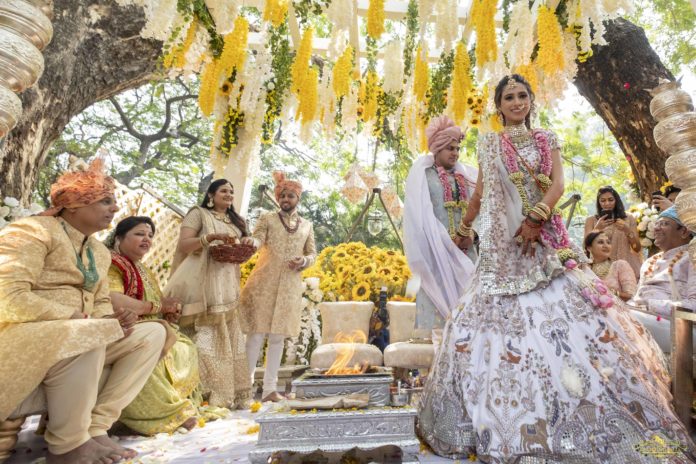Rituals are an integral part of the Hindu marriage system. Tying the mangalsutra, saptapadi or seven vows and tying of the knot, are the tiny rituals that hold the marriage together. The most important of them all are the seven vows or saat vachan.
Hindu marriage is solemnised with the ‘God of Fire’ as its witness (agni sakshi). For the seven vows, the bridegroom encircles the holy fire seven times. It is amazing to witness, if one intensely thinks about it — how significant the blessings of deities and spoken words are in the most important relationship of one’s life? The couple leads the rest of their lives living by these spoken words, and living up to them, each day. Afterall, they are more than just words.
What is a promise? A declaration or assurance that someone would do something. A pledge. A commitment. I promise you! Promise is an affirmative future intent to abide by one’s words. Though there is no rule book to follow for a successful married life, the Vedic Hindu marriage system tries to assimilate some shared guidelines for the ease of understanding of the young couple who are all set to enter the new phase together, forever. If violated, there is no constitutional provision or court of law, wherein one can challenge these spoken eternal vows. But they truly are the backbone to a better understanding of matrimony. The onus of violating this promise is on both the partners and so is its success. A couple’s commitment towards each other goes beyond the spoken words and certifications. Once the mangalsutra ceremony is concluded, the bride and the groom are apprised of their duties and responsibilities in the married life. The nature of duties – inexhaustible – extends from partners to immediate family members, relatives to social circle. The Hindu way of life, tried to sum up the promises in a few vows, countable on fingers. The aim of these vows is to promote a healthy and happy marital relationship.
The oath is to be taken by both the spouses, as marriage is not a 50-50 partnership — it’s a 100 percent partnership. Both partners make separate vows. The priest reads the vows one by one and the individual accepts them by saying, “I agree to do so”, after each vow.
Vows by the Husband:
-
I will consider my wife to be the better half. I will look after her just as I look after myself.
-
Accepting her as in-charge of the home, I shall plan things in consultation with her.
-
I will never express dissatisfaction about any shortcomings in my wife. If there are any, I will explain them to her lovingly. I will support her in overcoming them.
-
I will have faith in my wife. I will never look at any other woman with wrong intent, nor have an illicit relationship.
-
I will be affectionate and treat my wife like a friend.
-
I will bring home my entire income to my wife. The household expenses will be incurred with her consent. I will always make an effort to ensure her comfort and happiness.
-
I will not find fault or criticise my wife before others. We will sort our differences and mistakes in privacy by ourselves.
-
I will have a courteous and tolerant attitude towards my wife. I will always follow a compromising policy.
-
If my wife is unwell, or is unable to fulfil some responsibility, or through some misunderstanding behaves wrongly, I will never withdraw support or refuse to fulfil my responsibilities towards her.
-
I will always do my best to encourage my wife to find self-fulfilment. I will always behave in a kind and loving manner toward her.
Vows by the Wife:
-
I will merge my personality with that of my husband, and truly become the better half. We will begin a new life together.
-
I will always treat my husband’s relatives with courtesy, respect and generosity, and spare no efforts to keep them happy and content.
-
I will work hard to perform the household work and support my husband. I will never be lazy.
-
With complete faith in my husband, I will live just as he desires. I will always be faithful to him.
-
I will always speak pleasantly, be service-minded, and have an attitude of contentment. I will never sulk, grumble or be jealous.
-
I will be frugal in running my household and will try to avoid wastefulness.
-
I will never be indifferent towards my husband and will treat him like God.
-
If there are any differences with my husband, I will resolve them peacefully and not present them in a derogatory manner.
-
I will keep my husband content with humility and service.
-
Even if my husband is indifferent towards me, without any consideration I will faithfully fulfil my responsibilities.









